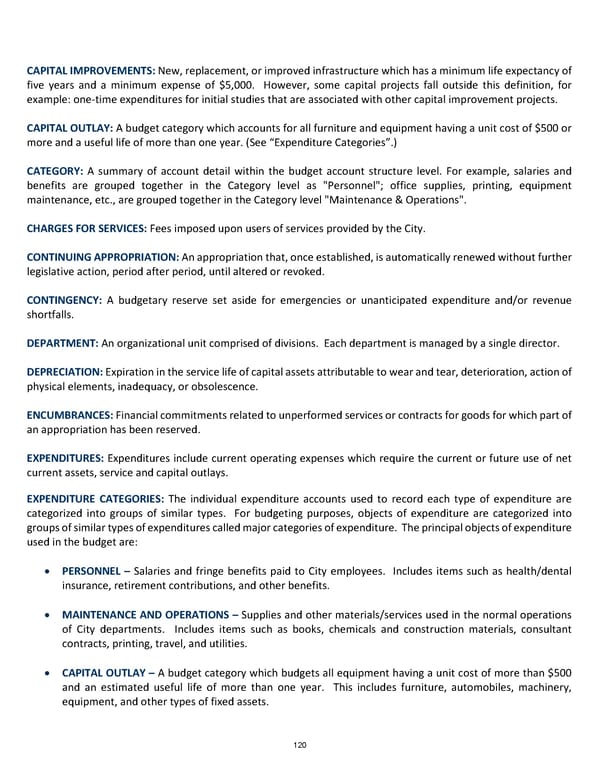CAPITAL IMPROVEMENTS: New, replacement, or improved infrastructure which has a minimum life expectancy of five years and a minimum expense of $5,000. However, some capital projects fall outside this definition, for example: one-time expenditures for initial studies that are associated with other capital improvement projects. CAPITAL OUTLAY: A budget category which accounts for all furniture and equipment having a unit cost of $500 or more and a useful life of more than one year. (See “Expenditure Categories”.) CATEGORY: A summary of account detail within the budget account structure level. For example, salaries and benefits are grouped together in the Category level as "Personnel"; office supplies, printing, equipment maintenance, etc., are grouped together in the Category level "Maintenance & Operations". CHARGES FOR SERVICES: Fees imposed upon users of services provided by the City. CONTINUING APPROPRIATION: An appropriation that, once established, is automatically renewed without further legislative action, period after period, until altered or revoked. CONTINGENCY: A budgetary reserve set aside for emergencies or unanticipated expenditure and/or revenue shortfalls. DEPARTMENT: An organizational unit comprised of divisions. Each department is managed by a single director. DEPRECIATION: Expiration in the service life of capital assets attributable to wear and tear, deterioration, action of physical elements, inadequacy, or obsolescence. ENCUMBRANCES: Financial commitments related to unperformed services or contracts for goods for which part of an appropriation has been reserved. EXPENDITURES: Expenditures include current operating expenses which require the current or future use of net current assets, service and capital outlays. EXPENDITURE CATEGORIES: The individual expenditure accounts used to record each type of expenditure are categorized into groups of similar types. For budgeting purposes, objects of expenditure are categorized into groups of similar types of expenditures called major categories of expenditure. The principal objects of expenditure used in the budget are: • PERSONNEL – Salaries and fringe benefits paid to City employees. Includes items such as health/dental insurance, retirement contributions, and other benefits. • MAINTENANCE AND OPERATIONS – Supplies and other materials/services used in the normal operations of City departments. Includes items such as books, chemicals and construction materials, consultant contracts, printing, travel, and utilities. • CAPITAL OUTLAY – A budget category which budgets all equipment having a unit cost of more than $500 and an estimated useful life of more than one year. This includes furniture, automobiles, machinery, equipment, and other types of fixed assets. 120
 FY 2024-25 Adopted Operating Budget and Capital Improvement Program Page 134 Page 136
FY 2024-25 Adopted Operating Budget and Capital Improvement Program Page 134 Page 136